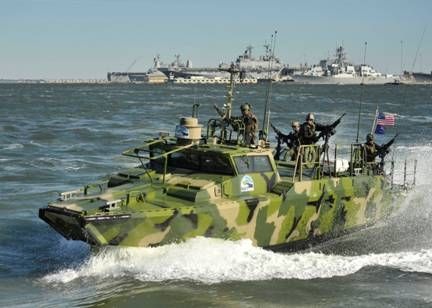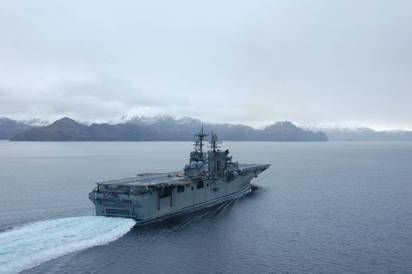The Department of Navy has been selected as a finalist in three categories in the international competition for the 2010 Platts Global Energy Awards. The awards recognize individuals and organizations that have demonstrated excellence in leadership, innovation and performance in the energy field. Prior winners include Exxon Mobil, Shell, Walmart, and the Tennessee Valley Authority.
The finalists were selected by a panel of international industry experts from over 200 nominations submitted from more than 30 countries.
“Selection of the Navy as a finalist in three categories in the same year is unprecedented for a military service,” said Rear Admiral Philip Cullom, director of the Energy and Environmental Readiness Division of the Chief of Naval Operations staff, and the architect of Task Force Energy. “I am pleased to see the Navy’s energy accomplishments recognized by this prestigious awards program.”
The Navy’s achievements in each of the three finalist categories are indicated below.
Category: Industry Leadership Award
The Navy’s establishment of aggressive energy goals and its implementation of Task Force Energy qualified the service as a finalist for this award. The award is given to an organization that has taken decisive action resulting in a substantial transformation in its energy posture.
The Chief of Naval Operations created Task Force Energy with the mission of enhancing the Navy’s strategic, tactical and operational capabilities through greater energy efficiency and development of more secure and sustainable energy supplies. Secretary of the Navy Ray Mabus issued amplifying and visionary energy goals that will transform Navy energy use over the next ten years, moving the Navy from a vulnerable and unsustainable petroleum-based energy strategy to the widespread use of alternative/renewable fuels for ships and aircraft.
Key Navy achievements thus far include the Earth Day 2010 flight of an F/A-18 aircraft on a 50/50 blend of camelina-based biofuel and petroleum based fuel and the October 2010 operation of an experimental riverine command vessel on a 50/50 blend of algae-based biofuel and petroleum.
“These achievements demonstrate significant progress in meeting the Secretary of the Navy’s goal of supplying half the Navy’s energy needs with alternative fuels by 2020,” said Cullom.
Category: Energy Efficiency Program of the Year
The Navy’s Incentivized Energy Conservation (i-ENCON) program has qualified the service as a finalist for this award. The award is given to the top energy management program that effectively improves an organization’s energy use.
The i-ENCON program encourages and rewards bottom-up management practices and cultural change in fuel usage by Navy ships. Vessels demonstrating a reduction in fuel usage while maintaining all operational commitments are rewarded by additions to their operating budget. This program also disseminates to all ships the fuel-saving lessons learned by each in areas such as managing fuel consumption, adjusting transit speed, selecting fuel efficient routes, and eliminating unproductive energy expenditures.
“We are proud of the Navy’s i-ENCON program,” said Cullom. “During Fiscal Year 2009, Navy ships achieved savings of more than $99 million in fuel costs, as compared with the projected amounts. These are significant savings.”
Category: Engineering Project of the Year
The commissioning and operation of USS MAKIN ISLAND (LHD 8), the Navy’s first ship incorporating an electric Auxiliary Propulsion System (APS) - also referred to as a hybrid electric drive - has qualified the service as a finalist for this award, which is presented for engineering excellence.
Although similar technology is widely used in automobiles, it has never been adapted to power a large vessel. The ship employs gas turbines and electric motors and services rather than the typical steam powered turbines, greatly improving overall energy efficiency. Gas turbines are inefficient when operating at low speeds – something large deck amphibious ships spend significant time doing.
By using its APS for speeds of 10 knots or less, fuel costs were reduced by $2 million during the ship’s 2009 maiden voyage from Mississippi to San Diego. Total fuel savings over the ship’s lifetime will amount to nearly $250 million.
“Where possible, the Navy will be an 'early adopter' of new technologies that enhance national security in an environmentally sustainable way," said Cullom. “The USS MAKIN ISLAND is a great example how the Navy is leading the way to achieve energy efficiency.”
The international winners of the 2010 Platts Global Energy Awards will be announced December 2, 2010.
To learn more about the U.S. Navy’s Energy, Environment and Climate Change programs, visit http://greenfleet.dodlive.mil.

100422-N-XXXXS-001 PATUXENT RIVER, Md. (April 22, 2010) The Navy celebrates Earth Day by showcasing a supersonic flight test of the "Green Hornet," an F/A-18 Super Hornet strike fighter jet powered by a 50/50 biofuel blend. The test, conducted at Naval Air Station Patuxent River, Md., drew hundreds of onlookers, including Secretary of the Navy Ray Mabus. Mabus has made research, development, and increased use of alternative fuels a priority for the Department of the Navy. (U.S. Navy photo by Kelly Schindler/Released)

101022-N-6889J-107 NORFOLK (Oct. 22, 2010) Sailors assigned to Riverine Group 1 conduct maneuvers aboard Riverine Command Boat (Experimental) (RCB-X) at Naval Station Norfolk. The RCB-X is powered by an alternative fuel blend of 50 percent algae-based fuel and 50 percent NATO F-76 fuel, supporting the Secretary of the Navy's efforts to increase the use of alternative fuels in Navy vessels. (U.S. Navy photo by Mass Communication Specialist 2nd Class Gregory N. Juday/Released)

090815-O-0000X-001 STRAIT OF MAGELLAN (Aug. 15, 2009) The amphibious assault ship Pre-Commissioning Unit Makin Island (LHD 8) sails easterly through the Strait of Magellan as the ship prepares to enter the Pacific Ocean. Makin Island departed Pascagoula, Miss., July 10 and is currently circumnavigating South America to its new homeport in San Diego. (Photo courtesy of Chilean Navy/Released)
Source: US Navy
This press release is presented without editing for your information only.























